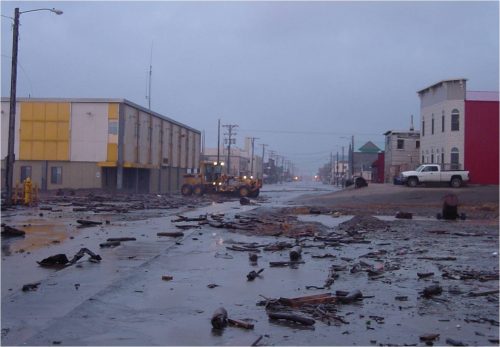Study shows stronger winds in store for northwestern Alaska
December 6, 2019
Heather McFarland
907-687-4544

By 2099, winds along Alaska’s northwestern coasts are projected to grow stronger, according to a new study from the University of Alaska Fairbanks.
To understand past and future winds, programmer Kyle Redilla, of UAF’s International Arctic Research Center, and Sarah Pearl, an undergraduate from Dartmouth College, analyzed over 30 years of data from 67 airports across the state. They used the observations, along with simulations by two global climate models, to predict future changes in wind.
The study, the first of its kind, was published in the journal Atmospheric and Climate Sciences in October. Redilla and Pearl are presenting the findings at the American Geophysical Union meeting Dec. 9-13 in San Francisco.
According to the research, wind changes are expected at many locations across Alaska. In general, wind speeds are projected to increase in winter and decrease in summer. However, the most startling result is the increase in high-wind events along the northwestern coasts.
Storms in these regions have already been increasing over the past three decades. Based on the most sensitive model, they could triple in frequency at some locations by the end of the 21st century. The strong winds that affected Nome and much of northwestern Alaska during the Thanksgiving week of 2019 were driven by the type of storm that the study identified.
“Wind is important because it causes a lot of damage. It drives coastal flooding. It drives infrastructure damage,” said John Walsh, IARC’s chief scientist and a study co-author.
Recent years have demonstrated wind’s devastating effects on Alaskans. Wind-driven waves caused massive flooding to Bering Sea communities in 2018. A separate storm eroded 15 feet of bluff near Dillingham, threatening the community’s sewage lagoon.
The study found a relationship between wind events and sea ice loss. “The places in which we saw an increasing frequency of events happened to be correlated with places that we’re also seeing diminishing sea ice,” Pearl said.
In northwestern Alaska, sea ice has historically provided a buffer protecting communities from potential damage during winter storms. “Given that the ice is going away, this increase in high wind events has implications for additional coastal flooding and erosion,” Walsh explained.
The authors indicate that these research findings are linked to ongoing climate change and are consistent with the global northward shift in storm tracks.
Few studies have examined past wind in Alaska, and no known studies have assessed future changes to high-latitude winds.
“Wind data are problematic,” Walsh said, which is one reason wind has not been studied as often as other climate variables, such as temperature and precipitation. The switch to modern instruments and the alteration of sensor elevations have affected the consistency of records.
A large part of Redilla’s analysis involved looking for abrupt jumps in the data, which indicate a change in instrumentation or sampling technique. Once identified, he corrected the pre-jump record to be consistent with the data after. Redilla also reduced bias in the modeled historic and future wind by adjusting the model output to closely approximate the actual winds recorded at the airports.
“We have a whole bunch of real-life data and then we have model output corresponding to the same points in time,” Redilla explained. “We take the distribution of the observed data and basically shift the model output to match.”
To make this research as useful as possible, the team produced a web-based tool allowing anyone to view and download the historic (1980–2014) wind data for Alaska. The tool is being expanded to include projected future changes in high-wind events.
Pearl participated in the study through IARC’s Research Experience for Undergraduates program, with Walsh as her mentor.
ADDITIONAL CONTACTS: John Walsh, jewalsh@alaska.edu; Kyle Redilla, 810-623-3046, kmredilla@alaska.edu; Sarah Pearl, 310-570-6639, Sarah.T.Pearl.20@dartmouth.edu.


